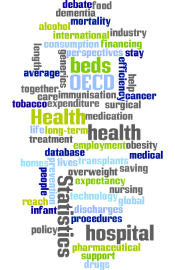Health
OECD Health Statistics 2023
|
|
The 2024 edition of the online database OECD Health Statistics will be released early July, in the new dissemination platform OECD Data Explorer. The online database OECD Health Statistics 2023 has been released on July 3, 2023. Access all datasets in the 2023 online database Need help navigating the database ? Read the user's guide on how to create tables in OECD.Stat
|
| DIRECT ACCESS TO THE ONLINE DATASETS IN OECD.STAT |
|
Health Expenditure and Financing |
| Key results |
|
Based on the latest estimates, the average OECD health expenditure to GDP ratio declined from a peak of 9.7% at the height of the pandemic in 2021 to 9.2% in 2022. The share of GDP going to health remains above the pre-pandemic level of 8.8% even if in 11 OECD countries the ratio in 2022 is expected to have fallen below 2019 pre-pandemic levels. Looking at country level data, the health expenditure to GDP ratio remained by far the highest in the USA at 16.6% in 2022, followed by Germany at 12.7% and France at 12.1%. A further 14 high-income countries, including Canada and Japan, all spent more than 10% of their GDP on healthcare in 2022. In many Central and Eastern European OECD countries, as well as in Latin American OECD countries, spending on health accounted for between 6 9% of their GDP. Finally health expenditure as a share of GDP was below 6% in Mexico, Luxembourg and Türkiye. |
| Sources and Methodology | List of indicators |

Access the full information on Definitions, Sources and Methods, as available in OECD.Stat but from one single user-friendly document |
The full list of indicators available in the online database, in English and in French
Avoidable mortality
|
DISCOVER ALL THE OECD WORK ON HEALTH STATISTICS
The OECD carries out work on health data and indicators to improve international comparisons and economic analyses of health systems. OECD Health Statistics and Health at a Glance are, respectively, the leading statistical database and publication for international comparisons of health and health systems. They help policy makers, researchers, journalists and citizens compare the performance of health systems across OECD and partner countries.
|
|
Health Expenditure: A System of Health Accounts (SHA) Access the latest data and main comparative tables and charts on health expenditure. |
|
|
Healthcare Quality and Outcomes The HCQO project compares the quality of health services in different countries. Access data on the following topics: Primary Care, Prescribing in Primary Care, Acute Care, Mental Healthcare, Patient Safety, Cancer Care and Patient Experiences. |
|
|
Health at a Glance This series of key statistical publications provides the latest comparable data on different aspects of the performance of health systems in OECD countries. Also, access the EU Country Cancer Profiles 2023 released in February 2023, as well as the Country Health Profiles 2023, released in December 2023 as part of the State of Health in the EU Cycle. |
In addition, the OECD analyses health system performance through policy projects.
POLICY RESPONSE TO THE COVID-19 CRISIS
|
|
See more health analysis on COVID-19 and learn about our work on Health Systems Resilience |
CONTACT US
 Follow us on Twitter via @OECD_Social
Follow us on Twitter via @OECD_Social
Related Documents




